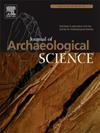高精度的年代学和对Panchi镜的科学分析揭示了帝制早期中国国家政策的影响
IF 2.5
1区 地球科学
Q1 ANTHROPOLOGY
引用次数: 0
摘要
作为战国时期(公元前475-221年)和汉代(公元前206 - 220年)中国最重要的手工艺品之一,铸镜业为了解青铜生产行业对逐渐升温的政治经济生态和国际贸易与交流的反应提供了独特的证据来源。Panchi镜是一种分布广泛、年代久远的镜型。本文对中国南方栾安地区出土的40块盘池镜的样式、铭文、合金工艺、铅同位素比和微量元素模式进行了系统的分析,这些盘池镜可分为秦朝至西汉初(公元前221-141年)两个阶段。新的数据揭示了两类镜子,第一类镜子深受楚式镜子的影响,采用特殊的合金技术(高铅低锡)铸造,并使用了一种短寿命的铅源;第二类镜子标志着著名的汉代镜子传统的开始,其特点是合金技术(低铅高锡)控制良好,铜源更多样化。Panchi镜的高精度年表使得镜面铸造行业的这一重要转变可以固定在文帝(公元前180-157年)和景帝(公元前157-141年)统治期间,当时汉早期的国家政策恢复和休整取得了丰硕成果,并为繁荣的经济做出了贡献,而不是被广泛认为是西汉王朝(公元前202-8年)的武帝(公元前141-87年)时期。本文章由计算机程序翻译,如有差异,请以英文原文为准。
High-precision chronology and scientific analysis of Panchi mirrors reveal the state policy impact in early Imperial China
As one of the most important handicrafts in China during the Warring States period (475–221 BCE) and the Han dynasty (206 BCE – 220 CE), the mirror-casting industry provides a unique source of evidence to understand the response of the bronze production industry to the gradually febrile political-economical ecology and international trade and exchange. This paper focuses on the Panchi mirror, which is a widespread mirror type with long chronology. Systematic analysis is performed on style, inscription, alloying technology, lead isotope ratio and trace element pattern of 40 Panchi mirrors unearthed from Luan region of Southern China, dated to two phases within the Qin to early Western Han dynasties (221-141 BCE). The new data reveals two mirror categories, the first being deeply influenced by Chu-style mirrors and cast by special alloy technology (high lead low tin) and using a short-lived source of lead, and the second marking the start of the well-known Han mirror tradition, characterized by a well-controlled alloying technology (low lead high tin) and more diversified copper sources. The high-precision chronology of the Panchi mirror allows this crucial transformation in the mirror-casting industry to be anchored around the reign of the Emperors Wen (180–157 BCE) and Jing (157–141 BCE), when the early Han state policy of Restoration and Recuperation became fruitful and contributed to a thriving economy, rather than the period of Emperor Wu (141–87 BCE), which is widely accepted as the peak of the Western Han dynasty (202–8 BCE).
求助全文
通过发布文献求助,成功后即可免费获取论文全文。
去求助
来源期刊

Journal of Archaeological Science
地学-地球科学综合
CiteScore
6.10
自引率
7.10%
发文量
112
审稿时长
49 days
期刊介绍:
The Journal of Archaeological Science is aimed at archaeologists and scientists with particular interests in advancing the development and application of scientific techniques and methodologies to all areas of archaeology. This established monthly journal publishes focus articles, original research papers and major review articles, of wide archaeological significance. The journal provides an international forum for archaeologists and scientists from widely different scientific backgrounds who share a common interest in developing and applying scientific methods to inform major debates through improving the quality and reliability of scientific information derived from archaeological research.
 求助内容:
求助内容: 应助结果提醒方式:
应助结果提醒方式:


